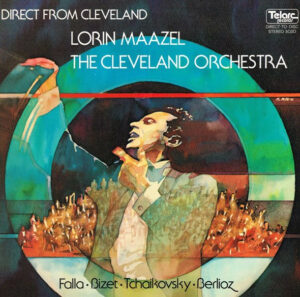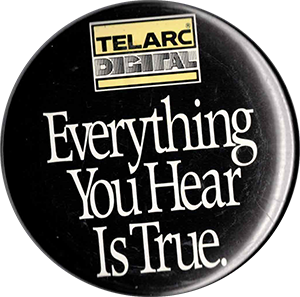Direct From Cleveland

On December 16, 1976, the musicians of the Cleveland Orchestra received a memo from the team at Advent Recording Company regarding an upcoming recording session. “A unique recording process will be used during these sessions,” wrote producer Robert Woods, “which is called ‘direct-to-disc’. This process involves recording un-edited performances of complete record sides, recorded directly to the ‘master disc’ without the use of a tape recorder.”1 (Click here to see the memo.) By eliminating the step of magnetic tape and subsequent transfer to disc, along with the sonic limitations of that process, a higher quality recording could be created.2 Also known as “direct cut,” these recordings were popular among audiophiles and were particularly championed by Doug Sax of Sheffield Labs.3 The sound of this first Telarc release greatly impressed Washington Star music critic Irving Lowens, who wrote, “I was knocked into the middle of next week!”4
Unfortunately, this process had two very important limitations. The first fell on the performers: during the recording sessions, the musicians had to perform an entire disc side at once. No stopping, no going back, and most stressful of all, no mistakes. Woods assured the musicians that “the risk factors in this project are high, but these risks are almost exclusively our own and we do not wish to create any unnecessary concern for your role in the project.”5 The orchestra certainly felt the pressure, but the results spoke for themselves.6
The other limitation of direct-to-disc recording is the manufacturing process. With typical LP records, the recorded tape is used to cut a lacquer, the lacquer to press a master, the master to press multiple stampers, and the stampers to press the discs.7 (Click here to see a diagram of the process.) Each of these parts wears out after a number of uses, which limits the number of discs available for sale. When the master wears down, no more discs can be produced. And no more profit can be made. While Direct From Cleveland made a big splash for the company (click here for a notable example), Renner and Woods understood the limitations of this approach. As Jack told fellow engineer Irv Joel in 2003, “we realized that making direct cut records was not the way to fame and fortune!”8 So after Direct from Cleveland they began exploring the new technology of digital audio. And for their next project, they once again had to look no farther than their own city, to Cleveland native Frederick Fennell and the Cleveland Symphonic Winds. This brings us to a recording that was dreamed up beside a fireplace in northern Ohio on a snowy evening in February of 1978.9
Last updated on April 16th, 2024 at 01:58 pm
- Memo, Robert Woods to the players of the Cleveland Orchestra, Dec. 16, 1976. Courtesy of the Cleveland Orchestra Archives. ↩︎
- This website explains the advantages to potential customers of the process. ↩︎
- Sax was one of the principal antagonists against the coming rise of digital audio, as colorfully detailed in “Perfect Sound? Whatever,” chapter six of Greg Milner’s Perfecting Sound Forever.
Greg Milner, Perfecting Sound Forever : An Aural History of Recorded Music (New York: Faber and Faber, 2010). ↩︎ - Washington Star, September 18, 1977 quoted in Rosenberg, The Cleveland Orchestra Story, p. 466 ↩︎
- Memo, Woods to Cleveland Orchestra. ↩︎
- There is no digital master for a Direct-to-Disc release, so this project is not available online. ↩︎
- Thanks to Dave Polster of Well Made Music for an explanation of this process and for the explanatory graphic. ↩︎
- Irv Joel, “Interview with Jack Renner (AES Legends Series)” (Audio Engineering Society, October 12, 2003). ↩︎
- Jack Renner tells the Telarc origin story in several places, including interviews with Irving Joel, Susan Schmidt Horning, and Jonathan Scull. ↩︎
